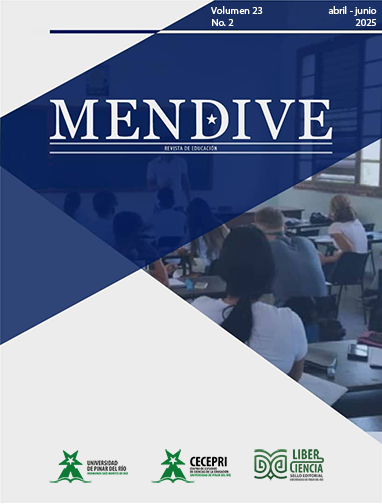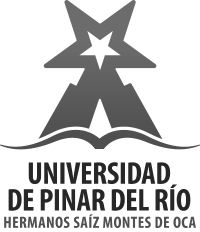GeoGebra y la competencia "resuelve problemas de forma, movimiento y localización" en profesores de secundaria
Contenido principal del artículo
Resumen
La educación matemática viene constituyendo un desafío global en el siglo XXI, visibilizando la necesidad de adaptar nuevas formas de enseñanza, de tal manera que permita el desarrollo de distintas competencias, entre ellas, la competencia resuelve problemas de forma, movimiento y localización, la cual consiste en lograr que los alumnos apliquen conceptos geométricos en dos dimensiones o tres, incluyendo mediciones y descripciones de trayectorias. Este artículo tiene como objetivo determinar si la propuesta de incorporación del software GeoGebra en la educación matemática del nivel secundario contribuye al logro de dicha competencia. El presente trabajo tuvo un enfoque cualitativo, nivel exploratorio, tipo básico y diseño fenomenológico. La investigación se llevó a cabo con una guía de entrevista a trece profesores de secundaria de la provincia de Lambayeque de la asignatura de Matemática. Se obtuvo como principal resultado que al emplearse el software GeoGebra en la enseñanza de la matemática, los estudiantes de educación secundaria de Lambayeque desarrollaron dicha competencia, lo que permite concluir que existe la necesidad de emplear la herramienta tecnológica del GeoGebra de manera obligatoria en los colegios de esta región.
Descargas
Detalles del artículo

Esta obra está bajo una licencia internacional Creative Commons Atribución-NoComercial 4.0.
Citas
Aguirre, G., & Velasco, L. (2021). Representaciones sociales develadas sobre la comprensión del territorio en estudiantes de práctica social universitaria, en el marco de una unidad didáctica. Eleuthera, 23(1), 38-55. https://doi.org/10.17151/eleu.2021.23.1.3
Ausubel, D. P. (1967). Learning theory and classroom practice. Ontario Institute for Studies in Education Bulletin, 1, 31.
Ayanwale, M., Mosia, P., Molefi, R., & Shata, L. (2023). Reliability Components of Online Teaching and Learning Tools in Lesotho Higher Education Institutions: A Systematic Review. Pertanika Journal of Science & Technology, 31(1), 595-614. https://doi.org/10.47836/pjst.31.1.34
Borgobello, A., & Monjelat, N. (2019). Vygotsky en la sociedad digital. Análisis de literatura científica actual. Perspectivas Metodológicas, 19. https://doi.org/10.18294/pm.2019.2200
Bravo, C., & Cedeño, F. (2023). Pólya method to strengthen skills in problems of linear equations of the. Journal Scientific MQR, 7(1), 74-93. https://doi.org/10.56048/MQR20225.7.1.2023.74-93
Henríquez-Rivas, C., & Verdugo-Hernández, P. (2023). Diseño de tareas en la formación inicial docente de matemáticas que involucran las representaciones de una función. Educación matemática, 35(3), 178-208. https://doi.org/10.24844/em3503.06
Mevarech, Z., & Kramarski, B. (1997). IMPROVE: A multidimensional method for teaching. American educational research journal, 34(2), 365-394. https://doi.org/10.3102/00028312034002365
Mex, D., Hernández, L., Cab, J., & Castillo, M. (2020). El desarrollo cognoscitivo de la parábola según Bruner, con el empleo de software educativo. Revista Científica UISRAEL, 8(1), 145-164. https://doi.org/10.35290/rcui.v8n1.2021.402
Ministerio de Educación. (2020). Currículo Nacional. Ministerio de Educación. https://n9.cl/br4b6n
Oddone, K. (2023). University Educators' Experience of Personal Learning Networks to Enhance Their Professional Knowledge. International Review of Research in Open and Distributed Learning, 24(3), 56-76. https://doi.org/10.19173/irrodl.v24i3.7053
Padilla, J., Rojas, L., Valderrama, C., Ruiz, J., & Cabrera, K. (2022). Herramientas digitales más eficaces en el proceso enseñanza-aprendizaje. Horizontes. Revista de Investigación en Ciencias de la Educación, 6(23), 669-678. https://doi.org/10.33996/revistahorizontes.v6i23.367
Pumacallahui, E., Acuña, C., & Calcina, D. (2021). Influencia del software GeoGebra en el aprendizaje de la geometría en estudiantes de cuarto grado de secundaria en el distrito de Tambopata de la región de Madre de Dios. Educación Matemática, 33(2), 245-273. https://doi.org/10.24844/em3302.10
Santos-Trigo, M., Barrera-Mora, F., & Camacho-Machín, M. (2021). Teachers' Use of Technology Affordances to Contextualizeand Dynamically Enrich and Extend Mathematical Problem-Solving Strategies. Mathematics, 9(793), 2-21. https://doi.org/10.3390/math9080793
Slavíèková, M. (2021). Implementation of Digital Technologies into Pre-Service Mathematics Teacher Preparation. Mathematics, 9(12), 1319. https://doi.org/10.3390/math9121319
Tourón, M., Tourón, J., & Navarro-Asencio, E. (2024). Validación española de la Escala de Detección de altas capacidades, Gifted Rating Scales 2(GRS 2-S) School Form, para profesores. Estudios sobre Educación, 46, 33-55. https://doi.org/10.15581/004.46.002


